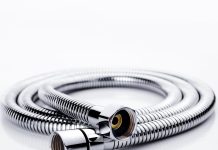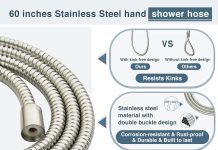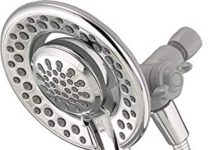In the world of showers, one might wonder if they all are equipped with flow restrictors. Flow restrictors limit the water from the showerhead, aiming to conserve water and promote sustainability.
But are they present in every shower? Join us as we explore the fascinating world of showers and uncover the truth behind the elusive flow restrictors.
Table of Contents
Common Types of Shower Heads
Standard Shower Heads
Standard shower heads are the most commonly used shower heads in households. They provide a steady, even water flow and are typically fixed to the wall. Standard shower heads come in various shapes and sizes, allowing users to choose one that best suits their preferences. These shower heads are easy to install and require minimal maintenance.
Rainfall Shower Heads
Rainfall shower heads are designed to mimic standing under a gentle rain shower. They feature a wider surface area and larger water nozzles, resulting in a cascading water flow. This showerhead provides a luxurious and relaxing showering experience, making it popular among those who enjoy a spa-like atmosphere in their bathrooms.
Handheld Shower Heads
Handheld shower heads offer flexibility and convenience as they are attached to a flexible hose that allows users to direct water flow wherever they desire. These shower heads are handy for individuals with limited mobility or tasks such as rinsing off soap or cleaning the shower walls. They provide versatility and ease of use, making them a popular option in many bathrooms.
Dual Shower Heads
Dual showerheads combine the features of standard and handheld shower heads. They usually consist of a fixed shower head mounted on the wall and a detachable handheld shower head that can be used separately or with the fixed head. Dual shower heads provide the best of both worlds, offering the convenience of a handheld shower head while still providing a fixed shower head for a more traditional showering experience.
What is a Flow Restrictor?
Definition
A flow restrictor, also known as a water restrictor or a flow regulator, is a small device installed inside a shower head to limit the amount of water that flows through it. It restricts water flow by reducing the water passageway’s size or by incorporating small holes or grooves that regulate the water flow.
Purpose
The primary purpose of a flow restrictor is to conserve water and promote water efficiency. By reducing the water flow, flow restrictors help minimize water consumption during showers, thereby saving water and energy. They aim to balance providing an adequate showering experience and using water responsibly.
Benefits and Drawbacks
The benefits of flow restrictors include water conservation, energy efficiency, and cost savings. Flow restrictors help reduce water bills and promote a more sustainable lifestyle by limiting the amount of water used. However, some drawbacks of flow restrictors include a reduced water flow, which may result in a less practical showering experience for those who prefer a more substantial water pressure.
Shower Heads with Flow Restrictors
Importance of Flow Restrictors
Shower heads with flow restrictors play a crucial role in water conservation efforts. With increasing concerns about water scarcity and environmental sustainability, it is essential to use water responsibly. Flow restrictors ensure showers do not consume excessive amounts of water, even if the user forgets to turn the tap off or adjust the shower settings.
Regulation Requirements
Many countries and regions have implemented regulations that require shower heads to be equipped with flow restrictors. These regulations aim to enforce water conservation practices and reduce water wastage. By adhering to the regulatory requirements, manufacturers ensure that their shower heads comply with the standards set by authorities to promote water efficiency.
Pros and Cons
Shower heads with flow restrictors offer several advantages. They help conserve water, making them an eco-friendly choice. They also contribute to energy efficiency, as less hot water is consumed during showers, lowering energy bills. Additionally, they promote responsible water usage and create awareness about the importance of conservation.
However, some people may find the reduced water flow of shower heads with flow restrictors a drawback. Those who enjoy intense water pressure or have specific needs, such as rinsing thick hair or lathering up quickly, may feel that their showering experience is compromised. In such cases, it may be necessary to consider alternative options.
Shower Heads without Flow Restrictors
Older Shower Heads
Older shower heads, particularly those manufactured before the implementation of water conservation regulations, may not be equipped with flow restrictors. These shower heads are designed to provide a high water flow and may not have the same water-saving features as newer models. It is important to note that using older shower heads without flow restrictors may contribute to increased water consumption.
Non-Compliant Shower Heads
Some shower heads on the market may not comply with current regulations and do not include flow restrictors. These non-compliant shower heads may offer a higher water flow than their regulated counterparts. Purchasing non-compliant shower heads may result in wasteful water usage, which goes against water conservation principles.
Circumventing Flow Restrictors
It is worth mentioning that there are ways to remove or modify flow restrictors in shower heads. However, tampering with flow restrictors should be approached with caution and knowledge of local regulations. Understanding the potential consequences and implications of bypassing flow restrictors is essential, as it may lead to increased water consumption and legal issues.
How to Check for a Flow Restrictor?
Visual Inspection
To check if a shower head has a flow restrictor, start by examining the shower head. Look for a small disk or screen near the connection point between the shower head and the water supply. This disk or screen is often the flow restrictor. If present, it may be possible to remove or modify the flow restrictor with the right tools and knowledge.
Water Pressure Test
Another way to determine if a shower head has a flow restrictor is by conducting a water pressure test. Turn on the shower and observe the water flow. A flow restrictor is likely installed if the water flow feels weak or lacks intensity. However, remember that the water pressure may be influenced by other factors, such as plumbing issues, so it is advisable to consult a professional if unsure.
Benefits of Flow Restrictors
Water Conservation
One of the primary benefits of flow restrictors is their contribution to water conservation. By limiting the amount of water used during showers, flow restrictors help to conserve this precious resource. Conserving water is essential for the environment and future generations to ensure a sustainable water supply.
Energy Efficiency
Flow restrictors indirectly promote energy efficiency by reducing the consumption of hot water. As less hot water is used during showers, the demand for heating water decreases. This results in energy savings and lower utility bills, making flow restrictors an economically beneficial choice in the long run.
Cost Savings
Another advantage of flow restrictors is the potential cost savings they offer. By conserving water and reducing hot water consumption, flow restrictors can lead to lower water bills and reduced energy expenses. These cost savings can increase over time, making flow restrictors a financially wise investment.
Drawbacks of Flow Restrictors
Reduced Water Flow
The primary drawback of flow restrictors is the reduced water flow they provide. Some individuals prefer intense water pressure during showers, as it can be invigorating and help with effectively rinsing off soap and shampoo. The reduced water flow with flow restrictors may not meet the preferences of those who desire a more forceful showering experience.
Less Effective Showering Experience
In addition to reduced water flow, the overall showering experience may feel less satisfying for some individuals when using shower heads with flow restrictors. The sensation of water raining down or the convenience of a high-pressure spray may be compromised. This can be subjective, as showering preferences vary from person to person.
Removing or Modifying Flow Restrictors
Reasons to Remove or Modify
There may be circumstances where individuals decide to remove or modify flow restrictors in their shower heads. Some common reasons include personal showering preferences, addressing plumbing issues, or perceiving flow restrictors as hindrances to an enjoyable showering experience. It is essential to consider such actions’ potential consequences and legality carefully.
Legal Considerations
Before removing or modifying flow restrictors, it is essential to understand the local regulations and legal requirements regarding water conservation. Tampering with flow restrictors without proper knowledge and authorization may violate these regulations and result in fines or penalties. It is advisable to consult with a professional plumber or local water authorities for guidance.
DIY Methods
If removing or modifying the flow restrictor is deemed necessary and legal, various do-it-yourself (DIY) methods can be employed. These methods involve using pliers, screwdrivers, or needle-nose pliers to remove or adjust the flow restrictor. However, it is crucial to exercise caution to avoid damaging the shower head or causing water leaks during the process.
Conclusion
Understanding the Role of Flow Restrictors
Flow restrictors are significant in conservation efforts and in promoting responsible water usage during showers. They help conserve water, promote energy efficiency, and contribute to cost savings. Although they may reduce water flow and potentially affect the showering experience, their sustainability benefits outweigh these drawbacks.
Choosing the Right Shower Head
When selecting a showerhead, one must consider personal preferences, water conservation goals, and compliance with local regulations. Standard shower heads, rainfall shower heads, handheld shower heads, and dual shower heads each have advantages and are suitable for different needs.
By choosing the right showerhead and understanding the role of flow restrictors, individuals can enjoy a satisfying showering experience while consciously conserving water and energy.





















